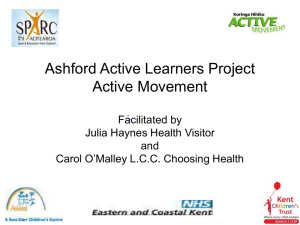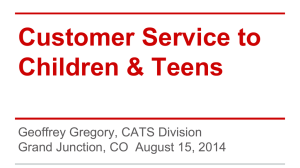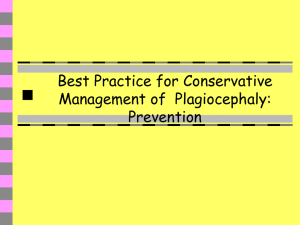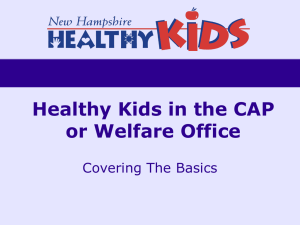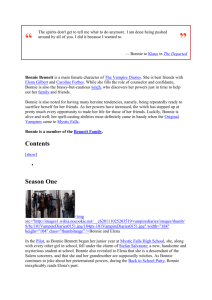Increase Physical Activity
advertisement
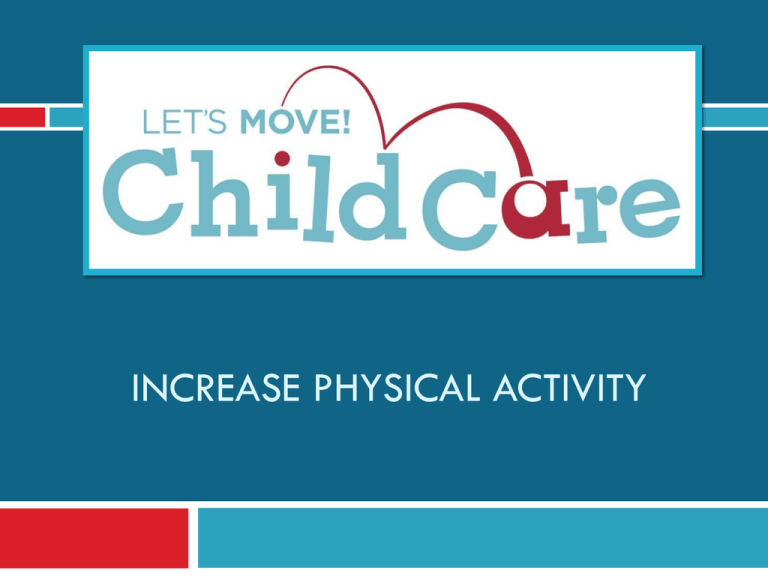
INCREASE PHYSICAL ACTIVITY Learning Objectives 1) Understand Let’s Move! Child Care Goals and best practices for physical activity 2) Know the benefits of physical activity 3) Get strategies and ideas to keep kids active 4) Learn about the resources and tips available on the Let’s Move! Child Care website: www.HealthyKidsHealthyFuture.org Rainbow Run When I call out one of the colors of the rainbow, run and touch 3 things that are that color. Knowledge Check What is the recommended amount of physical activity for toddlers in full day care? 15 - 30 min 30 - 45 min 60 - 90 min 90 - 120 min Knowledge Check What is the recommended amount of physical activity for toddlers in full day care? 15 - 30 min 30 - 45 min 60 - 90 min 90 - 120 min Physical Activity Best Practices Infants: Short supervised periods of tummy time several times each day Toddlers & Preschoolers: Active play time every day, both indoor and outdoor Toddlers: 60 – 90 minutes or more (for half-day programs, 30 minutes or more) Preschoolers: 120 minutes or more (for half-day programs, 60 minutes or more) Make sure that kids with special needs can participate in activities too! Benefits of Physical Activity Helps children stay at a healthy weight In childhood In adulthood – physical activity habits learned in early childhood can last a lifetime Benefits of Physical Activity (2) Helps children: Develop motor skills and build their strength, flexibility, and endurance Develop and maintain strong bones Benefits of Physical Activity (3) Improves social skills and brain development Helps children feel confident about themselves and their bodies Reduces children’s risk of feeling stressed or depressed Helps children sleep better Benefits of Physical Activity (4) Children who are active tend to have fewer behavioral and disciplinary problems, do better in school, and have longer attention spans in class. My Bonnie Lies Over the Ocean My Bonnie lies over the ocean, My Bonnie lies over the sea, My Bonnie lies over the ocean, O bring back my Bonnie to me. Bring back, bring back, O bring back my Bonnie to me, to me. Bring back, bring back, O bring back my Bonnie to me. 2 Kinds of Physical Activity 1. 2. STRUCTURED: Organized, quick, and intense activities led by adults UNSTRUCTURED: Free play to stimulate creativity and use the imagination Ways to Get Kids Moving Add physical activity to your daily routine Have children act out a story as you read it. Encourage kids to move like different animals during transitions from one activity or room to another. Use props to help kids move and identify shapes, colors, and numbers. Ways to Get Kids Moving (2) Mix up the usual ‘hokey pokey’ and ‘head, shoulders, knees and toes’ with a dance party or obstacle course. Encourage working together to come up with games and activities. Get Moving Time! Move around the room like the motions of weather: Rain Wind Thunder Snow Sunshine Where to Play Opt for outdoors as much as possible! Be warm-weather-ready. Play outside even when it’s chilly, rainy, or snowing. Find indoor options like a school gym, part of your classroom, or a room in your home. Make sure the play space is safe! Keep infants active too! Tummy Time: Is allowing babies to interact and play while awake and on their tummies Prepares babies for sliding on their bellies and crawling Should be done 2 or 3 times a day. Begin with 3-5 minutes at one time. When you see the infant enjoying the activity, gradually increase the time. What to do during tummy time Encourage infants to see, touch, and feel what’s around them. Place different toys in a circle around the baby and let the baby reach for them. Reaching helps the baby develop muscles to roll over, crawl, and scoot. Always make sure infants have tummy time when they’re awake and alert. Place infants on a solid surface on the floor (never on a surface that’s soft or up high like a mattress or sofa). Tummy Time Tips Some babies will not like tummy time at first so try putting their favorite toys just out of reach. A great time to do tummy time is following a diaper change or when the baby wakes up from a nap. Know the Developmental Milestones Kids should do specific things at every age and stage. Know the milestones to help them work on the appropriate physical and motor skills. Chart of Developmental Milestones Physical Activity Video: Motion Moments Be a Get Moving Role Model Participate in and enjoy physical activity. If you have limitations, be a cheerleader! Wear comfortable clothing and shoes. Break Time! March to your break and pretend to play your favorite instrument. Have someone guess which instrument you are playing! Physical Activity Best Practices in Review Pop Quiz! Can you recite all of the physical activity best practices without looking at your notes? Physical Activity Best Practices in Review Infants: Short supervised periods of tummy time several times each day Toddlers & Preschoolers: Active play time every day, both indoor and outdoor Toddlers: 60 – 90 minutes or more (for half-day programs, 30 minutes or more) Preschoolers: 120 minutes or more (for half-day programs, 60 minutes or more) Make sure that kids with special needs can participate in activities too! Finding resources and tips Visit www.HealthyKidsHealthyFuture.org www.HealthyKidsHealthyFuture.org Physical Activities Fun ideas, tips, activity sheets, and more! Visit www.HealthyKidsHealthyFuture.org www.HealthyKidsHealthyFuture.org Ideas and Resources One stop shop for nutrition and physical activity resources for all providers Resources in Spanish Available in English and Spanish Activity sheets eXtension Alliance for Better Child Care Hands-on Activities Database Songs to get kids dancing Nutrition & Physical Activity Curriculum (with DVD) Available in English and Spanish Tip Sheets & Handouts Download the Handbook at: www.teamnutrition.usda.gov View Free Online Trainings More trainings coming soon! See What’s Working for Others! Activity Break Get on your feet for a fun activity! (that can be used with kids too!) Action Story New Fruits and Veggies at the Market What’s your next step? Write down action steps you can take to give kids opportunities to be active every day! Join LMCC & Stay Connected For more information and to sign up, visit: www.HealthyKidsHealthyFuture.org Contact the Let’s Move! Child Care Help Desk LMCCHelp@cdc.gov Share your success stories! www.healthykidshealthyfuture.org/home/resources/succ ess.html

